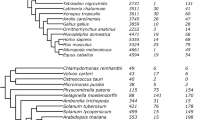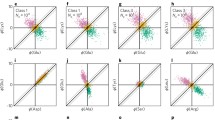Abstract
Amino acid sequence analysis and electrophoretic analysis of protein variation have been widely used for measuring genetic differentiation between diverging lines of descent. The problem of identifying the causes of protein evolution and divergence is, however, largely unsolved. Using data extracted from a collection of allozyme surveys of vertebrate species, we report here that protein heterozygosity is correlated with both protein genetic distance and protein amino acid substitution rate. Proteins with high heterozygosity are shown to have evolved at a faster rate than proteins with low heterozygosity. Evolutionary rate estimates obtained from the two techniques of amino acid sequencing and electrophoretic analysis are highly correlated over those proteins assayed by both methods. The observed relationship between protein heterozygosity and genetic distance cannot be completely accounted for by neutral theory, but suggests that a substantial proportion of genetic distance accumulated between species is the result of selective substitution.
Similar content being viewed by others
References
Sokal, R. R. in Ecological Genetics: The Interface (ed. Brussard, P. F.) (Springer, New York, 1978).
Riska, B. Evolution 33, 1001–1004 (1979).
Johnson, M. S. & Mickevich, M. F. Evolution 31, 642–648 (1977).
Pierce, B. A. & Mitton, J. B. Syst. Zool. 28, 63–70 (1979).
Skibinski, D. O. F. & Ward, R. D. Genet. Res. 38, 71–92 (1981).
Selander, R. K. in Molecular Evolution (ed. Ayala, F. J.) (Sinauer Associates, Sunderland, 1976).
Fuerst, P. A., Chakraborty, R. & Nei, M. Genetics 86, 455–483 (1977).
Chakraborty, R., Fuerst, P. A. & Nei, M. Genetics 88, 367–390 (1978).
Ward, R. D. Biochem. Genet. 16, 799–810 (1978).
Nei, M. Am. Nat. 106, 283–292 (1972).
Sarich, V. M. Nature 265, 24–28 (1977).
Wilson, A. c., Carlson, S. S. & White, T. J. A. Rev. Biochem. 46, 573–639 (1977).
Sonderegger, P. & Christen, P. Nature 275, 157–159 (1978).
Kimura, M. & Crow, J. F. Genetics 49, 725–738 (1964).
Chakraborty, R. & Nei, M. Evolution 31, 347–356 (1977).
Ohta, T. & Kimura, M. Genet. Res. 22, 201–204 (1973).
Maruyama, T. J. molec. Evol. 1, 368–370 (1972).
Nei, M. Molecular Population Genetics and Evolution (North-Holland, New York, 1975).
Nei, M. Am. Nat. 105, 385–398 (1971).
Kimura, M. Proc. natn. Acad. Sci. U.S.A. 76, 3440–3444 (1979).
Author information
Authors and Affiliations
Rights and permissions
About this article
Cite this article
Skibinski, D., Ward, R. Correlations between heterozygosity and evolutionary rate of proteins. Nature 298, 490–492 (1982). https://doi.org/10.1038/298490a0
Received:
Accepted:
Published:
Issue Date:
DOI: https://doi.org/10.1038/298490a0
- Springer Nature Limited
This article is cited by
-
Genetic divergence between east and west Atlantic populations of Actinia spp. sea anemones (Cnidaria: Actiniidae)
Marine Biology (2005)
-
Population differentiation and taxonomic status of the exploited limpet Patella candei in the Macaronesian islands (Azores, Madeira, Canaries)
Marine Biology (1996)
-
Evolutionary divergence between sympatric species of southern African Hakes, Merluccius capensis and M. paradoxus. I. Electrophoretic analysis of proteins
Heredity (1988)
-
Molecular evolution among someDrosophila species groups as indicated by two-dimensional electrophoresis
Journal of Molecular Evolution (1988)
-
A simulation study of the neutral evolution of heterozygosity and genetic distance
Heredity (1987)





